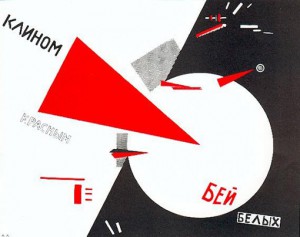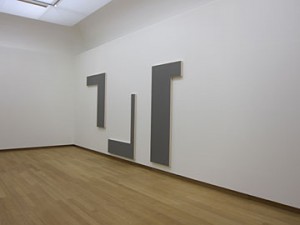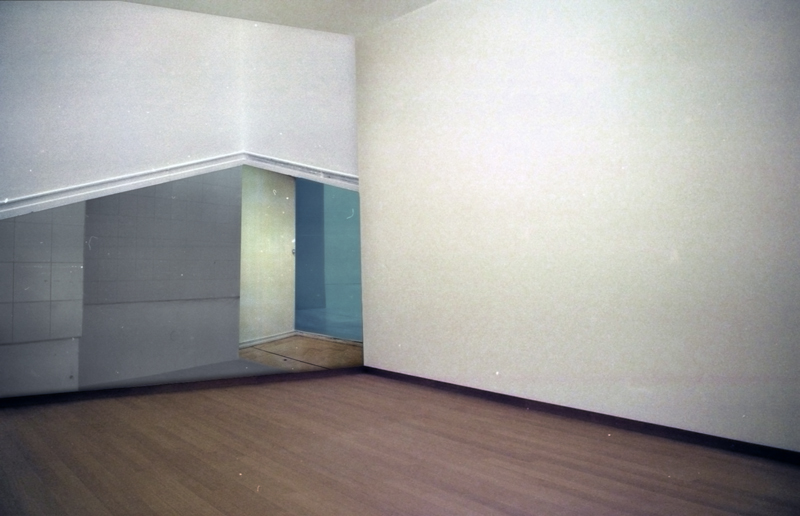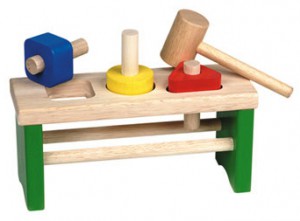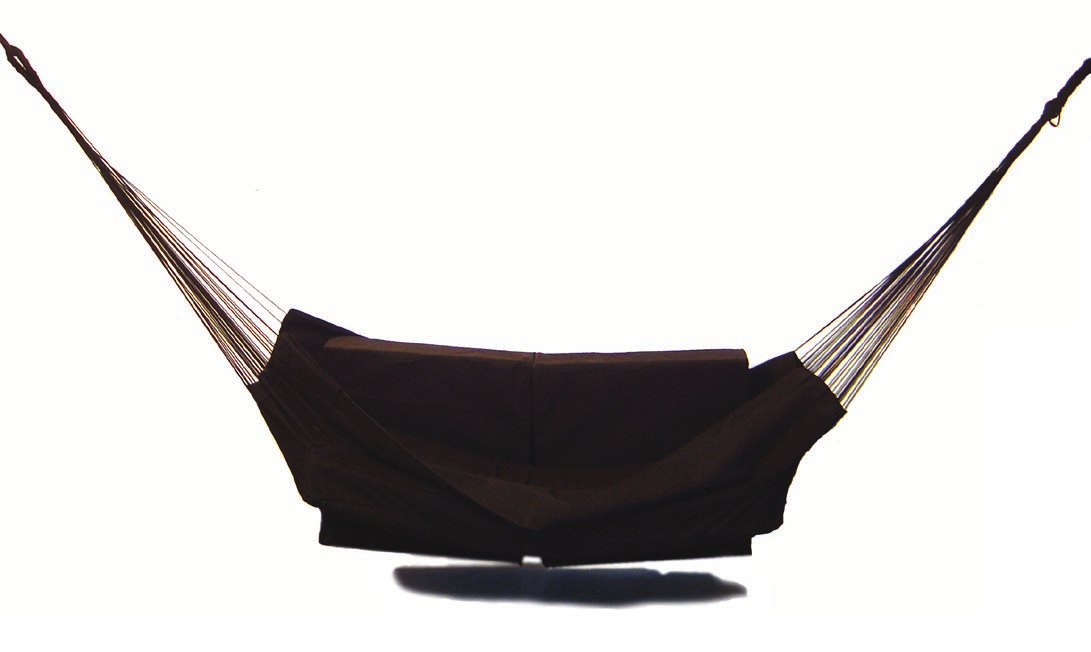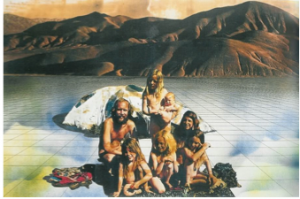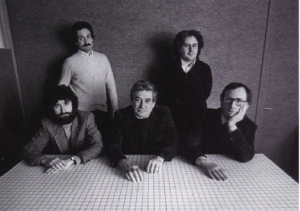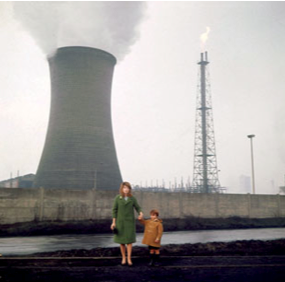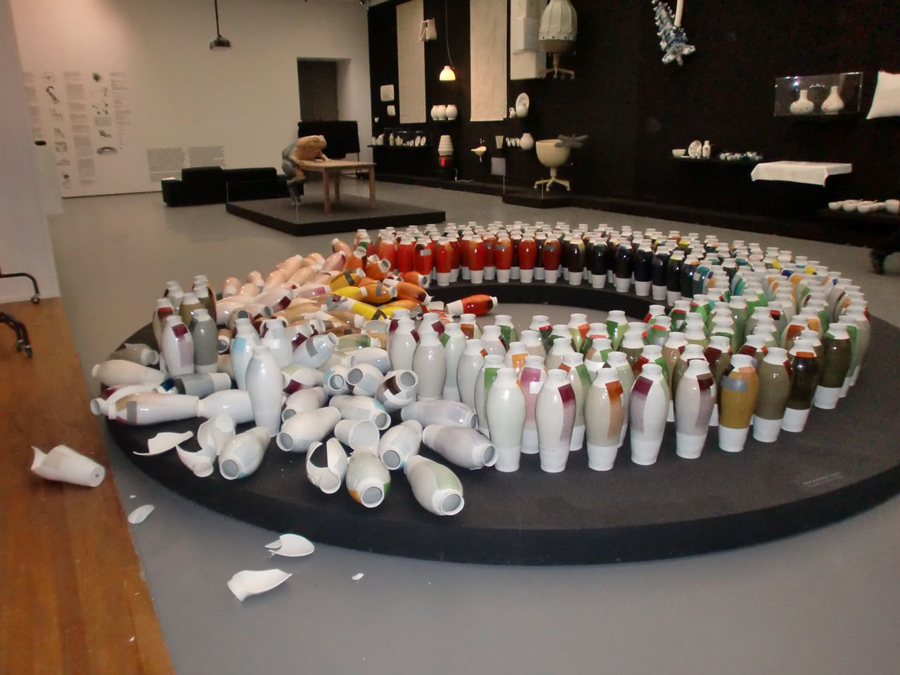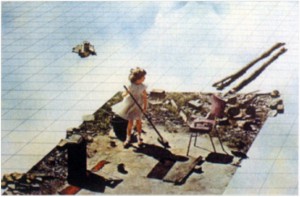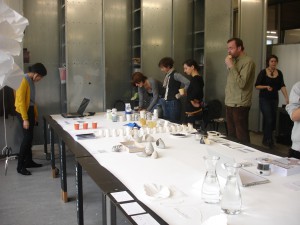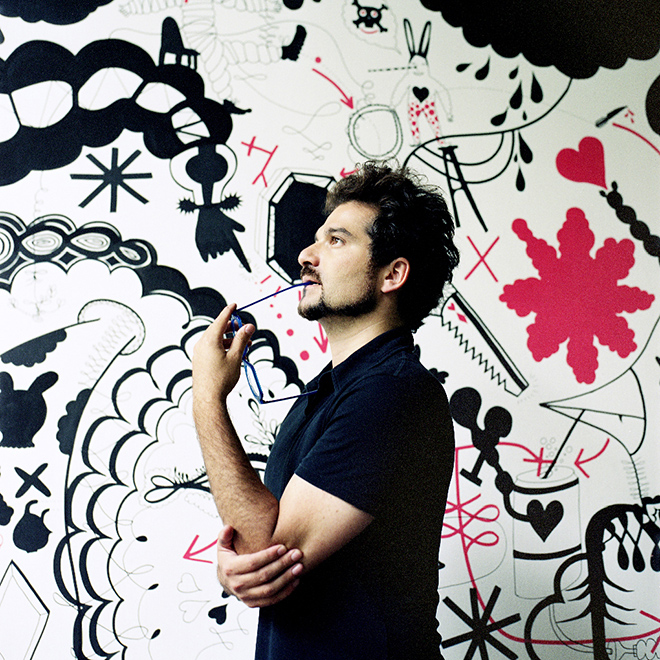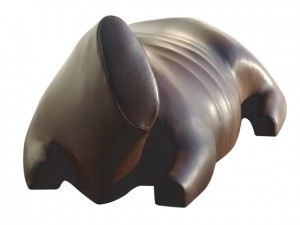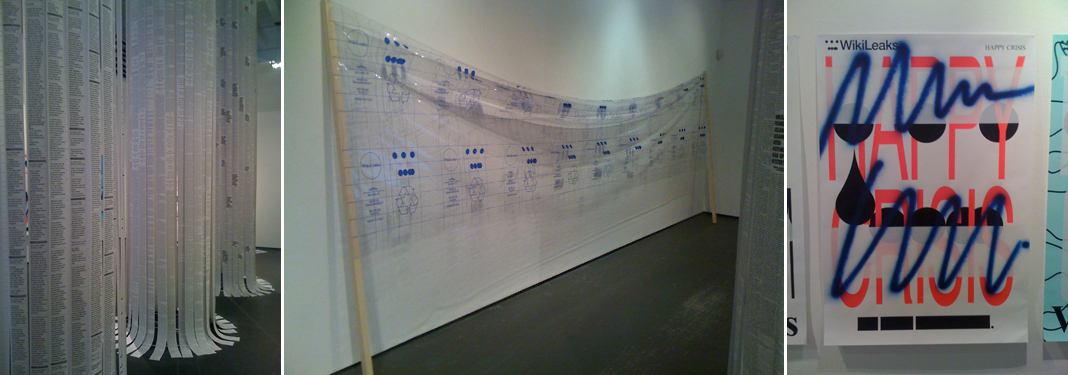It was quite hard for me to make a decision about one work of the Russian suprematist artist El Lissitzky, since this extreme emptiness and simplicity in images mostly gives me an uncomfortable feeling of being lost. On the other hand, it can also give me a feeling of structure, of organization and a somewhat mysterious clarity. So my feeling towards these means of visual language is kind of ambiguous. What is very interesting about the confrontation with abstract art, is that you either comprehend the piece (because you’ve read or heard about it or simply because you are part of the very same movement), or you don’t. If you don’t, you have to fill the empty brainspace with your own thoughts and ideas about the suggestion that is made or what is being implicated, which is most of the time impossible to guess without any information since it’s so abstract. How does a person that doesn’t know that Malevich’s Black Square is representing the party perceive the painting? And is it wrong if that person imagines that there is another meaning, just for him? I really don’t know.
I partly like how graphic elements are presented by Lissitzky and how they carry a connotation that has to be detected. They become emblems for and references to something so much more than themselves. So they turn into something completely different and in a way unworldly, but in a very modest, unpretentious way, sometimes even a tad clichéd. One of his propaganda posters in the exposition, “Beat the Whites with the Red Wedge” from 1919, is especially nice as an example. The red wedge is a symbol for the active bolshevists who are overcoming their rival, the white movement, interestingly enough represented by a white opening in a black background, which is pierced by the red triangle. I like the simple clarity of his choice, but am not a fan of the additional shapes and letters since they are too mysterious for me and disturb the beauty of the image in my eyes. Then again, it’s propaganda.
Do You Get It?
Saturday, March 5, 2011
New eyes
Friday, March 4, 2011
Looking back in time, trying to remember how I’ve learned to write and read, no memories appears. At least no memories that create a clear image of the learning process.
In elementary school we learned the letters. We learned how they look like, how they sound, how to write them and connect them into words. This process took quite long time I think and it’s difficult to be described in retrospect. In these classes, we all had to study on writing the same letters, but we all created different handwriting. Some could do it beautifully, some ugly to unreadable. How a handwriting can be unreadable?
Now, reading a ‘small’ book from a ‘big’ man – Gerrit Noordzij, helps me to realize why and how I can do this today. A book written even before I was born answers the question as simple as ‘the space’ and with writing especially the ‘white space’.
In our current time we see hundreds of images every day. Some we remember for a reason, some we forget immediately. How does our human brain read those images? What helps it in this process?
The “boom” of a new ways to process images started in the second half of the 19th century, when people started creating more spaces for museums and galleries. Later on with the use of architectural deconstructions, making them fairly big and “clean”, with the only purpose to contain some of those special images for us.
The use of space is very common in modern art. In some cases we actually perceive the space as a piece of the art. For example, if a work of art is placed in surrounding A, which is empty, it will be processed in your mind differently than in surrounding B, which is full with other objects.
In modern art we refer to surrounding A as the ‘White cube’, with its square or oblong shape, white walls and a light usually coming from the ceiling. A book from Brian O’Doherty (Inside the white cube – 1976), in which he confronted the modernist obsession with the white cube arguing that every object became almost sacred inside it, making the reading of art problematic.
As surrounding B was more standard in the few centuries before that. Then the exhibition space was the salon, a dark space so filled with works that it was difficult to see the beautiful, detailed paintings.
The importance of space can be found in different forms. Also in writing it plays a crucial roll in getting the message across, in other words: reading. In his book ‘ The stroke of the pen’ Gerrit Noordzij emphasise how the space in and around letters can make or brake the word and therefore the text.This space has to be put in rhythm. He writes: “The rhythmic connection of the white shapes in the word is the condition of the rhythm of the black shapes and vice versa.”
So this rhythm can be seen only in combination of letters. If a letter and subsequently a word doesn’t have its own space in and around it, then the white cube that belongs to the letter is impaired. As a result the word becomes just like an image hanging in saloon from 18 century.
Trying to understand this theory is like learning to read and write all over again. That opens a new perception on all written letters and words, how are they made and how they come across. Always look around and you’ll might see things in a new way…
Welcome all of you born and not yet dead!
Friday, March 4, 2011
De mens speelt zijn hele leven, elke dag, misschien wel elke minuut, een andere rol. Tegenover elk persoon verhoud je je anders. We leven met masker, kostuum en aangeleerde manieren. Zonder valt niet of nauwelijks te leven.
De ene dag ben je slecht, vijandig, dan weer lief en onschuldig of je voelt je als een zak aardappels.
Als ik me voel als een aardappelzak, zorg ik er voor dat de aardappelzak omhult is door een zwierige jurk en felle lippenstick. Uiterlijk is misleidend. De meeste zullen pas denken dat je een aardappelzak bent als je een jute doek omslaat en muf ruikt.
Mensen reageren op wat ze kennen.
Heb je een goude oorbel in dan ben je crimineel, homo of gabber. Cliche's zijn makkelijk.
Bij een slecht iemand denk ik meteen aan een kauwgom kauwende man met een leren jas en een snor. Dit plaatje zit vastgeroest in mijn hoofd.
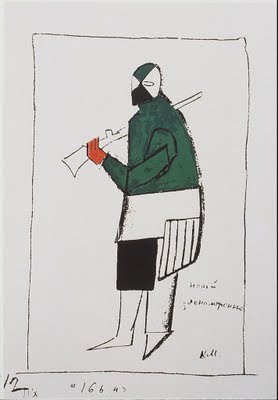
[costume for Man with Bad Intentions]
Toen ik het operastuk: De overwinning over de zon, met decors van Kasimir Malevich zag, was ik gegrepen door de vervreemdende taal en beeldtaal. Abstract. Weinig aanknopingspunten, waarin je vastgeroeste denkbeelden zou kunnen terugvinden. Ander taalgebruik, andere tonatie van de stem, abstracte kostuums.
Het karakter, de slechte man, kreeg in dit stuk een hoekig pak aan. Zonder dat het aansloot op zijn lichaam. De vorm van het pak werd eerst gemaakt. Daarna kon de slechte man zich hiertoe verhouden en aanpassen. Zijn bewegingsvrijheid hing af van het pak. In het kostuum zijn geen cliché’s gebruikt. Ook niet in het pak van de vijand, de nieuwe mens , de dikke man enz.
Dit vind ik een welkome verrassing en zelfs een opluchting. Doordat bewegingen, taalgebruik en kleding onherkenbaar blijven, dwingt het je anders te kijken, te denken en te luisteren. Niet te snel te oordelen. Het stuk is een zoektocht naar herkenningspunten in een wereld die je vreemd is. In dit stuk maak je je eigen waarheid zonder het zien van cliche's of rookwolken.
cube design
Wednesday, March 2, 2011
In the “beginning” all was dark… Paintings were hanging in dark rooms and the walls were so filled that one could barely see the landscape paintings for all the landscape paintings in the salon. Anyhow, most people were happy that they could consume the art, just like people since the ancient Vatican sculpture gardens. In 1812 the first “art-only” building was created by the English architect Sir John Soane. Finally! Here the art could be viewed for what it really was, perhaps even art selected with great taste, as Kant would have wanted it.
In the late 19 century the number of galleries and art museums were booming. Every “metropolis” had to have its own museum of art to be a metropolis. When we are approaching the mid 20 century old ways of building institutions of art, often retro romantic, were abandon for more “clean” and architectural deconstructed rooms, an early examples is the Guggenheim in New York. Exiting times.
At the Van Abbe-museum in Eindhoven you can walk around in beautiful, calm, strictly white and spiritual rooms filled with modernistic art. The worlds’ largest collection of Lissitsky paintings are finding its’ place like a perfect sized glove. Modern art for a modern room!
On the second floor an exhibition about art is presented. Or rather an exhibition of art. Or an exhibition of artworks about the modern art museum, but with new art. Or an exhibition on ehee.
When visiting this exhibition a feeling of unrest is present, an urge to maintain the “white cube” intact. The room can only be intact when art is made in respect of the cube. But what happens when people get tired of the white cube, when artist don´t agree that their works need the white cubes, when the curators finds them self unable to fill their holy rooms? Maybe the beautiful buildings of high modernism will slowly decay? Well to calm the museum directors I have taken my responsibility and re-used the modern room to create new room! Deconstructed the deconstructed. A post modern solution to keep modern. Now we all can sleep well.
Proun
Wednesday, March 2, 2011
De gehele expositie ‘monumenten voor de toekomst, El Lissitzky’ trof mij als warrig, misschien mede door het eerst kijken van het theaterstuk, waar hij aan had meegewerkt, uitgevoerd door Amerikaanse theatermakers, lang na zijn dood.
Theater is een ding, experimenteel theater een ander en een video-regristratie van experimenteel theater nog een stap verder van mijn bed. De bedoeling van de tentoonstelling is om te laten zien hoe dynamisch Lissitzky was, zijn werk is dat ook, vaak onaf, vol ideeën over de toekomst. Maar de meeste dynamiek die ik gevonden heb, zat in het kleinste kamertje van het Van Abbe Museum, het was ook de laatste ruimte die ik nog niet gezien had. Het was een video spel, geprojecteerd op een groot scherm met een comfortabele rode tweezitsbank er tegenover. Het was het spel ‘Proun‘ van Joost van Dongen, mede geïnspireerd op Lissitzky. je was een bal die voortstoof op een buis, je kon vooruit en draaien om de buis. onderweg waren er enkel geometrische vormen die uit de weg gegaan diende te worden, er was geen boven of onder, geen einde, enkel abstractie en zeer veel dynamiek. Wat het Van Abbe probeerde te bereiken via het werk van Lissitzky, is hen gelukt via een video game. Hier raakt de expositie aan de toekomst, en aan dynamiek, de kunst kan nog veel groeien en ontdekken in de wereld van de nieuwe media. Games, web-art, conceptuele kunst op je I-phone van alles is daar mogelijk. Jammer dat hier verder geen aandacht aan is besteed in de tentoonstelling. Het doel was immers een tentoonstelling te maken die lissitzky in deze tijd plaatst. bij het spel stond ook niet van wie het was, waarom het er was of dat het er überhaupt stond. een klein gemis
We love geometry
Wednesday, March 2, 2011
Geometry appeals to us. When I was very young, I remember playing with wooden squares, circles and triangles, trying to find the right hole for them. Apparently, we learn to recognize geometry’s basic shapes from an early age. Not only is it one of the oldest mathematical sciences, it provides practical knowledge to interpret size, volume and relative position of figures in all kinds of situations. Through the axioms of geometry, measurements can be reduced to a simple set of lines, making our world a very synoptic place and providing us with a feeling of – why not – security and intelligent understanding.
Eatable fashion and so on..
Wednesday, March 2, 2011
BLESS DESIGN was founded in 1997 by Ines Kaag in Berlin, and Desiree Heiss in Paris.
In ’99 and ’04 they received the ANDAM fashion award.
They’re philosophy is creative freedom, they are busy with totally innovative fashion accessories through design to art.
The Bless creative expression takes the form through numbered editions, with a permanent research of timelessness. They’re way is to create without definite perimeter.
The two designers escape from any calibrated definition of fashion, “BLESS does not promote any style – BLESS fits every style!” they kept tight they’re initial concept and idea which was to combine creations between fashion, design, art and architecture.
The objects created by Bless result from the fascination of Desiree Heiss and Ines Kaag for recycling, the diversion of the uses and the traditional techniques.
They’re accessories turn what was supposed to be regular and unquestionable into surprising.
Like, for example the shoe-socks, that is a socks boot like, with a sole under, or from the collaboration with Le Pliage®, the bag that can be folded inside it’s own circular leather handles and can be worn as a bracelet.
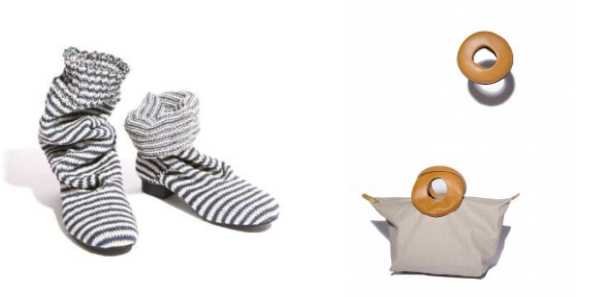
Superstudio
Tuesday, March 1, 2011
Superstudio was founded in 1966 in Italy by Natalini, Torrelado di Francia, Alessandro, Roberto Magris and Piero Frassinelli. The group developed as a result of the expanding cities, which contributed to the growing amount of products and design. Later on they focused more on architecture and they did cut-outs and city plans of over expanding cities.
In the 60s the post-war modernization was a fact in Italian society and decimating the surrounding urban landscape. Mussolini’s fascist regime contributed to the invitation of Italian mass society, but did not construct a mass consumer culture. That would be the accomplishment of the governments who supported private investment. There
was no sufficient safety regulation to ensure proper building methods. The result was catastrophic, with speculative buildings placed randomly through the urban margin. Italians were becoming more urban and more hooked with their object world, but adapting to this new consumer oriented lifestyle unavoidably meant that they came apart to traditional habits.
During this time the student population doubled to half a million, providing a force behind the rise of mass student culture. This slide towards social breakdown was brought into view through the work of some of the countries artists. Like Michelangelo Antonioni who with his film “Red dessert” showed a devastated landscape with factories and pollution. This was a reminder of a simpler past and reflected on the built environment.
Discussing Hella Jongerius
Monday, February 28, 2011
Na mijn eerste kennismaking met het werk van Hella Jongerius had ik direct een hele sterke mening gevormd.
Gaandeweg ik aan het schrijven was hoe ongelofelijk simpel ik haar werk vond zoals bijvoorbeeld een door haar ontworpen print voor een sneaker moest ik toch telkens mijn mening bijstellen.
Zodoende ben ik zeven keer overnieuw begonnen. Telkens uit een verschillend standpunt. Ik moest en zou duidelijk maken hoe ongelofelijk slecht ik haar werk vond. Maar telkens naarmate ik me meer en meer verdiepte bleek ik ongelijk te hebben.
Ik vond bijvoorbeeld uit dat wanneer ik in google: “Hella Jongerius kunst” intikte 32.400 resultaten kreeg. En wanneer ik: “Hella Jongerius design” intikte 163.000 resultaten kreeg. Ook op Facebook wordt zij twee keer onder design genoemd en niet onder kunst. Ook verschillende zoektermen in google geven duidelijk meer resultaten wanneer Hella Jongerius met zoekterm “design” word gebruikt.
Zo besloot ik: “Hella Jongerius moest uit het (kunst)museum.” Na verder research over design in kunst musea bleek het Boijmans van Beuningen zelfs vrij bekend is om de manier waarmee zij design een plek in het museum geven. Een designer (Wim Crouwel) was zelf in de jaren 90tig diresteur ervan. Daarbij bleek ook dat Jongerius zichzelf niet zo zeer een kunstenaar of designer noemt maar verschillende dingen op verschillende manieren benaderd. Het kwam er dus op neer dat Jongerius werk doordacht is. Iets meer probeert dan alleen maar design te zijn.
Zo kwam ik telkens mezelf weer tegen. En moest ik toch weer nuanceren. Door telkens opnieuw te beginnen en zoveel verschillende standpunten te hebben ingenomen ben ik heel veel te weten gekomen over Jongerius.
Nog steeds staat een groot deel van Jongerius werk me tegen. Maar wat ik wel ben gaan zien is dat ze niet alleen commercieel werk maakt of veel geld probeert te verdienen met reproducties. Wat ze doet komt wel degelijk ergens vandaan. Jongerius gaat te werk als een kunstenares en vormt vanuit daar vaak toch functionele objecten of gebruiksvoorwerpen. Dit begint al in het ontwerp proces. Ze stelt zo nog meer eisen als iemand die enkel vanuit kunst of enkel vanuit design beoordeeld. Designers die zich begeven in de kunstwereld worden geacht autonoom te kunnen werken met een eigen handschrift en/of thematiek. Maar tegelijk moeten ze aanvoelen wat de markt wil. Toch lukt Jongerius dit erg goed. En voert ze daarnaast een interessant onderzoek uit naar de cross-over tussen deze twee werelden die steeds vaker hand in hand gaan.
In mijn research naar Hella Jongerius en design in de kunstwereld kwam ik op een blog geschreven door “deDeurs” Naar aanleiding hiervan ontstond een discussie…
Anti-design
Thursday, February 3, 2011
Superstudio was founded in 1966 in Italy. The group developed as a result of the expanding cities, which contributed to the growing amount of products and design. Later on they focused more on architecture and on collages and cut outs they did city plans of over expanding cities.
I like the fact that their plans never became reality but their concepts were sold and exhibited. They established radical surrealistic visions of a negative environment as critiques of contemporary movements. They lived in a time when it was hard to escape from the time pressure and the fast developments. Like now, designers have to go outside expectations and think further and in the end present authentic products, sometimes-overdeveloped products. What Superdstudio did (in some of their work) was that they stopped during the process of development and did not finish it. This was a revolutionary way of thinking during that time. It is a concept that allows the spectators to walk into an unfinished world.
Superstudio has influenced a lot of designers and architectures today with its radical and revolutionary ideology. Rem Koolhaas is one of them who have made a lot extravagant projects. There is a similarity of the buildings he does and the Superstudios sketches. He is also more interested in the city and urbanisation and in a contradictive way he builds dynamic, futuristic buildings.
“ If design is merely an inducement to consume, then we must reject design. If architecture is merely the codifying of bourgeois model of ownership and society, then we must reject architecture. If architecture and town planning is merely the formalization of present unjust social divisions, then we must reject town planning and its cities until all design activities are aimed towards meting primary needs. Until then, design must disappear. “
I like the fact that their plans never became reality but their concepts were sold and exhibited. That is one reason I think they are more like artists then designers. They used their designer skills and knowledge but pushed it further so their work became artworks. A designer solves problems and an artist asks questions. Superstudio asked questions. They gave one solution out of millions and force the spectator to use his imagination to expand this solution.
In 1970 they did a furniture collection out of their “Grid concept”. It is a 3d object out of their drawings, so from design they made art, and from art they designed. But how come they neglected design when they at the same time were involved in it and produced? Is it fair to their belief? What they designed here was a response on the political issues that existed during that time and the disillusionment, which gave origin to a new society, which off course affected the art world. In this collection the furniture reminded of cheap café furniture’s from the 50s. The functionality and easiness of it was the main goal.
Cup or be Cupped : Designlab project
Wednesday, January 26, 2011
The aim of this project was to get introduced with the several methods of design research. This 3 week project took place under the supervision of Sophie Krier and Cynthia Hathaway. Because of the short time span in which the course took place, the schedule was packed full of activities, making it an intense first experience.
The case of this project was all about cups. We were to become cup professionals, gain the uttermost expertise in the world of the cup.
Jaime Hayón, Artist or Designer?
Friday, January 21, 2011
Choosing an artist from the list that we had been given, I quickly googled a few names and crossed that of Jaime Hayón who, during the 90ties, had studied at a Design Academy funded by Benetton (among others in Madrid, Paris and San Diego). He there had worked “closely with the legendary image-maker and agitator Oliverio Toscani” as is explained on his web site.[1]; (You might remember this one – made a few very critical commercials for the company, also the one displaying the anorexic girl)
Thrilled, I decided to go for Hayón only to find out that there is unfortunately nothing very controversial about him. With his 37 years, living practically all over in Europe, he is quite an internationally popular designer. Or artist?
Very hard to say, since he clearly works on both sides of the road.
He graduated as an industrial designer and has – until now – designed a whole range of, and very, industrial products such as for instance a bathroom collection for ArtQuitect, all kinds of domestic furniture for b.d ediciones, Established&Sons and Moooi, lighting fixtures for Metalarte and Swarovski, vases for Gaia and Gino, ceramic objects for Bosa Ceramiche and so on and so forth.[2]
There are however those other pieces he created, often marking major break-troughs in his career, that are more likely to be linked to the Fine Arts.
Julia Lohmann, dierenactiviste en designer
Friday, January 21, 2011
Cow benches (2005)
Ik heb me verdiept in het project Cow benches (2005) van Julia Lohmann, een serie van 18 leren banken in de vorm van koeien zonder kop en poten. Het leer is van koeien, en het is in precies dezelfde positie op ‘het dier’ (in dit geval schuim en hout) geplaatst als op het destijds nog levende dier. Haar concept: we zitten altijd op leren banken, maar je beseft niet dat het leer van koeien komt. Als je op een Cow bench zit, besef je je dat wel.
Wat mij interesseert in Julia Lohmann is dat ze in mijn ogen een dierenactiviste is, en dat door middel van design probeert te uiten. Ze schreeuwt niet om aandacht in demonstraties waarbij ze bloed op bontjassen gooit. Ze wil juist de consument zelf laten ervaren dat leer niet alleen een product is, maar ook deel van een levend wezen is geweest, dat wij voor onze consumptie geslacht hebben. Dit zorgt wat mij betreft voor een veel intensievere beleving dan een demonstratie.
Ik vraag me af of zo’n letterlijke weergave van haar onderwerp sterk genoeg is om het publiek te confronteren met hun dubbelzinnige, hypocriete houding ten opzichte van dieren.
Front Design – New flesh for Scandinavian design
Friday, January 21, 2011
If we talk nowadays about Scandinavian design we mostly talk about Ikea. Simple, strong and just to serve its purpose. But there is and should be more to it. There is a younger generation of Designers who are coming to seize the throne and take Scandinavian design into the next jump of design.
Filosofie op z’n hoogtepunt
Friday, January 21, 2011
Kunst en design. Vullen zij elkaar aan? Is het familie? Hebben zij überhaupt wel een relatie? Als ik mensen om mij heen vraag naar verschillen tussen kunst en design kom ik bedrogen uit. Lang nadenken wordt vervolgd door: ‘Ik heb geen idee’. Maar ook over overeenkomsten lijkt ‘men’ nog niet nagedacht te hebben. Een interessante kwestie dus. Om te beginnen zoek ik op wat kunst, en wat design, in de volksmond als betekenis krijgen opgespeld:
– Kunst: Kunst is alles wat door een mens is gemaakt en tot doel heeft menselijke zintuigen of geest te prikkelen door originaliteit of schoonheid.
– Design: Design is daarentegen de creatie van objecten, omgevingen, grafisch werken (en enzovoorts) beoogt, zowel op functioneel als op esthetisch gebied en afgestemd volgens de eisen van de industriële productie.
Kunnen wij zo stellen dat kunst met een functioneel doel design wordt genoemd?
1] Temple of Truth. Three 7m high “Roman” columns consisting of paper strips with gossip articles, press statements, and chats regarding WikiLeaks. Part of the Metahaven installation at Graphic Design Worlds at the Triennale Design Museum in Milan, and also part of the WikiLeaks Identity research project. January 2011. 2] Happy Crisis. This poster is part of the Metahaven installation at Graphic Design Worlds at the Triennale Design Museum in Milan, and also part of the WikiLeaks Identity research project. January 2011. 3] Radical Transparency. Transparent plastic banner. Part of the Metahaven installation at Graphic Design Worlds at the Triennale Design Museum in Milan, and the WikiLeaks Identity research project. Length: about 7m. January 2011.
